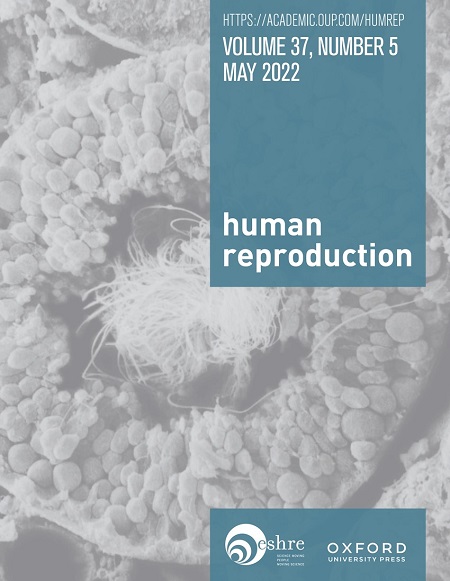Normozoospermic infertile men possess subpopulations of sperm varying in DNA accessibility, relating to differing reproductive outcomes.
IF 6
1区 医学
Q1 OBSTETRICS & GYNECOLOGY
引用次数: 0
Abstract
STUDY QUESTION Can a reliable assay be developed to quantify DNA accessibility in human sperm to help with the assessment of pre-implantation development affected by dense packaging of mammalian sperm's genetic material? SUMMARY ANSWER We adapted NicE-view, an assay that directly labels accessible DNA, for use in human sperm and applied it to examine spermatozoa from infertile individuals with distinct reproductive outcomes. WHAT IS KNOWN ALREADY Existing data suggest a connection between sperm chromatin compaction and reproductive outcomes. The assays used to generate this data, however, measure chromatin compaction indirectly and thus understanding their meaning is challenging. STUDY DESIGN, SIZE, DURATION Between April 2020 to December 2023, 60 normozoospermic infertile men were invited to participate in an experimental study and asked to provide a semen sample. PARTICIPANTS/MATERIALS, SETTING, METHODS Among the 60 individuals forty had undergone at least one treatment with ART. Among these ART-treated participants, 20 were included in the study because after fertilization only one or no embryos developed during embryo culture (low blastocyst growth rate, LBGR). The other 20 men were included as at least 50% of cultured embryos developed to the blastocyst stage (high blastocyst growth rate). Additionally, 20 previously infertile individuals obtained a pregnancy naturally (NATP) and were included as well. Washed spermatozoa obtained from seminal plasma or prepared by swim-up procedure were processed for NicE-view to determine DNA accessibility as a marker of chromatin condensation using confocal microscopy. Images of more than 3 million spermatozoa were acquired. Computer-assisted image segmentation was used to identify individual sperm heads and DNA accessibility levels were then quantified in each. We also compared NicE-view to chromomycin A3 (CMA3), a conventional marker of chromatin de-condensation, and ATAC-see, an alternative assay for measuring DNA accessibility. MAIN RESULTS AND THE ROLE OF CHANCE Both semen and swim-up samples of participants contained two well-delineated subpopulations of spermatozoa with distinct DNA accessibility levels, the frequencies of which varied among individuals. Interestingly, individuals with high frequencies of highly accessible sperm DNA, as measured in semen, possessed decreased sperm concentrations. Moreover, participants with high frequency of highly accessible sperm DNA were more common in the LBGR sub-group. Surprisingly, selection of motile sperm by swim-up enriched for sperm with high DNA accessibility in participants from all three sub-groups. Chromatin accessibility measurements by Nice-view were distinct from DNA staining with the fluorescent CMA3 dye, and NicE-view allowed much clearer separation of sperm subpopulations than ATAC-see. LIMITATIONS, REASONS FOR CAUTION This was a single-centre study with a cohort of 60 individuals. Sperm samples containing very high frequencies of sperm with increased DNA accessibility were more common in the LBGR sub-group. The number of individuals with this pattern was, however, limited, even within this category. WIDER IMPLICATIONS OF THE FINDINGS High DNA accessibility is associated with poor pre-implantation embryonic development in vitro and NicE-view may be used for the prediction of abnormal embryonic development in ART. Further studies examining samples from larger cohorts of participants and the localization of accessible regions within the sperm genome are needed to fully evaluate the utility of this method. STUDY FUNDING/COMPETING INTEREST(S) Swiss National Science Foundation (Grant No. 189264), Swiss Center for Applied Human Toxicology (SCAHT) research (Grant No. 1 'male reproductive toxicity') (both to C.D.G.), and the Novartis Research Foundation (to A.H.F.M.P.). M.E.G., C.D.G., and A.H.F.M.P. are authors on a patent application (EP23210754.0) on the use of NicE-view for the assessment of sperm. TRIAL REGISTRATION NUMBER ClinicalTrials.gov ID NCT04256668.正常精子不育男性拥有不同DNA可及性的精子亚群,这与不同的生殖结果有关。
研究问题:能否开发一种可靠的测定方法来量化人类精子中的DNA可及性,以帮助评估哺乳动物精子遗传物质密集包装对着床前发育的影响?我们改编了NicE-view,这是一种直接标记可接近DNA的检测方法,用于人类精子,并将其用于检查具有不同生殖结果的不育个体的精子。现有的数据表明,精子染色质压缩与生殖结果之间存在联系。然而,用于生成这些数据的分析是间接测量染色质压实的,因此理解其含义是具有挑战性的。研究设计、规模、持续时间在2020年4月至2023年12月期间,60名无精子不育男性被邀请参加一项实验研究,并被要求提供精液样本。参与者/材料、环境、方法在这60个人中,有40人至少接受过一次ART治疗。在这些接受art治疗的参与者中,有20人被纳入研究,因为受精后在胚胎培养过程中只有一个或没有胚胎发育(囊胚生长速率低,LBGR)。另外20名男性被纳入,因为至少50%的培养胚胎发育到囊胚期(囊胚生长速度高)。此外,20名先前不孕的人自然怀孕(NATP),也包括在内。从精浆中获得的洗净精子或通过游泳程序制备的精子被处理为NicE-view,使用共聚焦显微镜确定DNA可接近性作为染色质凝聚的标记。获得了300多万个精子的图像。计算机辅助图像分割用于识别单个精子头部,然后量化每个精子头部的DNA可接近性水平。我们还将NicE-view与chromomycin A3 (CMA3)进行了比较,后者是一种传统的染色质脱凝标记物,而ATAC-see是一种测量DNA可及性的替代方法。主要结果和偶然性的作用参与者的精液和游动样本都包含两个很好地描述的精子亚群,它们具有不同的DNA可接近性水平,其频率在个体之间有所不同。有趣的是,在精液中测量的高度可接近的精子DNA频率高的个体,其精子浓度较低。此外,具有高可及性精子DNA频率的参与者在LBGR亚组中更为常见。令人惊讶的是,在三个亚组的参与者中,游动精子的选择增加了具有高DNA可接近性的精子。通过Nice-view测量的染色质可接近性不同于用荧光CMA3染色的DNA染色,并且Nice-view比ATAC-see更清楚地分离了精子亚群。局限性和谨慎的原因:本研究为单中心研究,共纳入60例个体。在LBGR亚组中,含有非常高频率且DNA可接近性增加的精子样本更为常见。然而,即使在这个类别中,具有这种模式的个体数量也是有限的。高DNA可及性与体外植入前胚胎发育不良有关,NicE-view可用于预测抗逆转录病毒治疗中胚胎发育异常。为了充分评估这种方法的实用性,需要进一步的研究,检查来自更大的参与者群体的样本,并确定精子基因组中可接近区域的定位。研究资助/竞争利益(S)瑞士国家科学基金会(批准号189264),瑞士应用人类毒理学中心(SCAHT)研究(批准号1“男性生殖毒性”)(均授予C.D.G.)和诺华研究基金会(授予A.H.F.M.P.)。m.e.、c.d.g.和A.H.F.M.P.是一项关于使用NicE-view评估精子的专利申请(EP23210754.0)的作者。试验注册号clinicaltrials .gov编号NCT04256668。
本文章由计算机程序翻译,如有差异,请以英文原文为准。
求助全文
约1分钟内获得全文
求助全文
来源期刊

Human reproduction
医学-妇产科学
CiteScore
10.90
自引率
6.60%
发文量
1369
审稿时长
1 months
期刊介绍:
Human Reproduction features full-length, peer-reviewed papers reporting original research, concise clinical case reports, as well as opinions and debates on topical issues.
Papers published cover the clinical science and medical aspects of reproductive physiology, pathology and endocrinology; including andrology, gonad function, gametogenesis, fertilization, embryo development, implantation, early pregnancy, genetics, genetic diagnosis, oncology, infectious disease, surgery, contraception, infertility treatment, psychology, ethics and social issues.
 求助内容:
求助内容: 应助结果提醒方式:
应助结果提醒方式:


